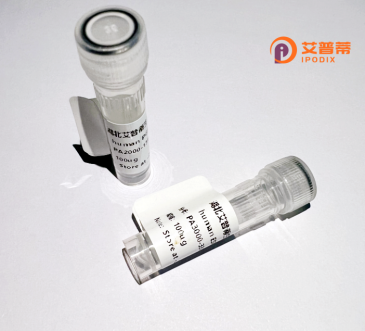
| 纯度 | >90%SDS-PAGE. |
| 种属 | Human |
| 靶点 | ALS2CR19 |
| Uniprot No | Q8TEW8 |
| 内毒素 | < 0.01EU/μg |
| 表达宿主 | E.coli |
| 表达区间 | 1-1205aa |
| 氨基酸序列 | MKVTVCFGRTGIVVPCKEGQLRVGELTQQALQRYLKTREKGPGYWVKIHHLEYTDGGILDPDDVLADVVEDKDKLIAVFEEQEPLHKIESPSGNPADRQSPDAFETEVAAQLAAFKPIGGEIEVTPSALKLGTPLLVRRSSDPVPGPPADTQPSASHPGGQSLKLVVPDSTQNLEDREVLNGVQTELLTSPRTKDTLSDMTRTVEISGEGGPLGIHVVPFFSSLSGRILGLFIRGIEDNSRSKREGLFHENECIVKINNVDLVDKTFAQAQDVFRQAMKSPSVLLHVLPPQNREQYEKSVIGSLNIFGNNDGVLKTKVPPPVHGKSGLKTANLTGTDSPETDASASLQQNKSPRVPRLGGKPSSPSLSPLMGFGSNKNAKKIKIDLKKGPEGLGFTVVTRDSSIHGPGPIFVKNILPKGAAIKDGRLQSGDRILEVNGRDVTGRTQEELVAMLRSTKQGETASLVIARQEGHFLPRELKGEPDCCALSLETSEQLTFEIPLNDSGSAGLGVSLKGNKSRETGTDLGIFIKSIIHGGAAFKDGRLRMNDQLIAVNGESLLGKSNHEAMETLRRSMSMEGNIRGMIQLVILRRPERPMEDPAECGAFSKPCFENCQNAVTTSRRNDNSILHPLGTCSPQDKQKGLLLPNDGWAESEVPPSPTPHSALGLGLEDYSHSSGVDSAVYFPDQHINFRSVTPARQPESINLKASKSMDLVPDESKVHSLAGQKSESPSKDFGPTLGLKKSSSLESLQTAVAEVRKNDLPFHRPRPHMVRGRGCNESFRAAIDKSYDGPEEIEADGLSDKSSHSGQGALNCESAPQGNSELEDMENKARKVKKTKEKEKKKEKGKLKVKEKKRKEENEDPERKIKKKGFGAMLRFGKKKEDKGGKAEQKGTLKHGGLREEELEKMKEERERIGAKHQELREKQARGLLDYATGAIGSVYDMDDDEMDPNYARVNHFREPCTSANVFRSPSPPRAGPFGYPRDGHPLSPERDHLEGLYAKVNKPYHPLVPADSGRPTGGSTDRIQKLRKEYYQARREGFPLYEDDEGRARPSEYDLLWVPGRGPDGNAHNLRFEGMERQYASLPRGGPADPVDYLPAAPRGLYKERELPYYPGAHPMHPPKGSYPRPTELRVADLRYPQHYPPPPAPQHKGPFRQDVPPSPPQHQRMPAYQETGRPGPRGGSPDQYPYRTQDSRQKNPMTAAV |
| 分子量 | 132 kDa |
| 蛋白标签 | GST-tag at N-terminal |
| 缓冲液 | 冻干粉 |
| 稳定性 & 储存条件 | Lyophilized protein should be stored at ≤ -20°C, stable for one year after receipt. Reconstituted protein solution can be stored at 2-8°C for 2-7 days. Aliquots of reconstituted samples are stable at ≤ -20°C for 3 months. |
| 复溶 | Always centrifuge tubes before opening.Do not mix by vortex or pipetting. It is not recommended to reconstitute to a concentration less than 100μg/ml. Dissolve the lyophilized protein in distilled water. Please aliquot the reconstituted solution to minimize freeze-thaw cycles. |
以下是关于PARD3B的三篇参考文献的简要信息,涵盖其功能及疾病关联研究方向:
1. **文献名称**: "PARD3B promotes colorectal cancer cell metastasis by activating EMT and RhoA signaling"
**作者**: Zhang Y, et al.
**摘要**: 该研究揭示PARD3B通过激活上皮间质转化(EMT)和RhoA信号通路促进结直肠癌转移,体内外实验表明其高表达与癌细胞侵袭性增强相关。
2. **文献名称**: "Role of PARD3B in maintaining apical-basal polarity and cell proliferation in mammary epithelial cells"
**作者**: McCaffrey LM, Macara IG.
**摘要**: 研究表明PARD3B通过与PAR3家族其他成员(如PAR3)的竞争性结合调控乳腺上皮细胞的顶-基极性,其失衡可导致细胞增殖异常,提示与乳腺癌发展相关。
3. **文献名称**: "Genomic amplification of PARD3B promotes breast tumorigenesis and is associated with poor prognosis"
**作者**: Feng Y, et al.
**摘要**: 通过基因组分析发现,PARD3B在乳腺癌中频繁扩增,其过表达通过激活PI3K/AKT通路驱动肿瘤发生,临床数据表明其高表达与患者生存率降低显著相关。
4. **文献名称**: "Structural basis for the interaction of PARD3B with phosphoinositides and its role in cell polarity"
**作者**: Wu H, et al.
**摘要**: 该研究解析了PARD3B蛋白的磷酸肌醇结合结构域,揭示其通过脂质互作调控细胞极性建立的分子机制,为理解PARD3B在发育和疾病中的作用提供结构基础。
以上文献覆盖了PARD3B在癌症转移、细胞极性调控、信号通路及分子机制等领域的研究进展。
PARD3B (Partitioning Defective 3 Homolog B) is a key scaffolding protein belonging to the PAR (Partitioning Defective) family, which regulates cell polarity, asymmetric cell division, and tight junction formation. It shares structural homology with PARD3/PAR3. containing conserved PDZ domains and a semi-aggrephilic domain, but differs in its N-terminal region due to alternative splicing. PARD3B is primarily expressed in polarized epithelial and neuronal cells, where it collaborates with PALS1 (MPP5) and CRB3 to establish apical-basal polarity and maintain tissue architecture.
Functionally, PARD3B orchestrates the assembly of polarity complexes by linking transmembrane proteins to cytoskeletal components. It interacts with atypical protein kinase C (aPKC) and CDC42. facilitating signaling pathways like Hippo and Wnt, which are critical for cell differentiation and proliferation. Dysregulation of PARD3B is implicated in cancer progression, with overexpression observed in breast, lung, and colorectal tumors, where it may act as an oncogenic driver by promoting cell migration, invasion, and epithelial-mesenchymal transition (EMT).
Emerging evidence also links PARD3B to neurodevelopmental processes, including neurite outgrowth and synaptic plasticity. Despite its physiological importance, PARD3B's distinct roles versus PARD3 remain partially understood. Ongoing research focuses on its dual context-dependent roles (tumor-suppressive or oncogenic) and potential as a therapeutic target. Its involvement in polarity-related pathways underscores its broad relevance in development, tissue homeostasis, and disease.
×